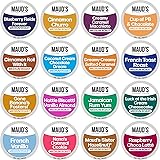Are you someone who loves the rich, bold flavor of espresso but sometimes finds it a bit too intense on its own? Perhaps a traditional espresso macchiato is the perfect balance you’ve been searching for. As expertly demonstrated by Austin Childress from Carabello Coffee in the video above, crafting this classic Italian drink at home is simpler than you might imagine. It is often misunderstood, but once its true identity is embraced, a world of nuanced coffee flavor is opened up.
The term “macchiato,” originating from Italy, literally translates to “marked” or “stained.” This concise definition perfectly encapsulates the essence of the drink: espresso, delicately marked with a small amount of steamed milk. This is not to be confused with a larger, milk-heavy latte or a cappuccino; the macchiato stands proudly as an espresso-forward beverage where the coffee’s character is intended to shine through with only a subtle softening provided by the milk. It is a testament to the idea that sometimes, less truly is more, especially when the quality of the espresso is high.
Understanding the Authentic Espresso Macchiato
For many, the idea of a macchiato might be influenced by popular chain coffee shops, where it is often presented as a much larger, sweeter, and more milk-heavy concoction, sometimes even layered with syrups. However, the true, traditional Italian espresso macchiato is a purist’s delight. It is prepared to highlight the unique characteristics of the espresso bean, allowing its full flavor profile—whether it is bright, fruity, chocolatey, or nutty—to be the star. The tiny dollop of steamed milk is simply a gentle counterpoint, subtly rounding off the espresso’s edges without masking its depth.
Imagine if a master painter wanted to add just a touch of light to a dark, intense portrait; the milk in a macchiato functions in a similar way. A small amount of white is introduced amidst the rich brown, signifying that the espresso has been “marked.” This intentional lightness ensures that the espresso’s inherent notes are not just present but are also allowed to remain dominant on the palate. Achieving this balance is a core part of mastering how to make a macchiato at home, ensuring that the espresso’s complexity is celebrated, not diluted.
Key Steps to Making Your Espresso Macchiato
Crafting an authentic espresso macchiato at home involves a few precise steps, beginning with the foundation: quality espresso. The process starts with selecting your preferred coffee beans, ideally freshly roasted and ground just before brewing. Austin’s method suggests using approximately 16.5 grams of ground coffee. This measurement is crucial as it helps ensure a balanced extraction, producing about 40 grams of liquid espresso, which is typically around two ounces. This careful attention to espresso brewing is paramount for a macchiato where the coffee’s flavor is truly at the forefront.
Next, the milk component is prepared. The goal here is not to create a large volume of foam but rather a small amount of warm, velvety microfoam. This microfoam is achieved by steaming milk just until it feels warm to the touch, or approximately between 140-150°F (60-65°C). Overheating the milk can cause it to lose its natural sweetness and develop an undesirable scalded taste. A careful eye is kept on the temperature to prevent the milk from becoming too hot, which would overpower the delicate espresso flavors.
Once the espresso is pulled and the milk is perfectly steamed, a small amount of the warm, frothy milk is poured directly onto the espresso. This creates the signature “mark” or “stain” that gives the macchiato its name. The intention is merely to soften the espresso’s intensity slightly, allowing its robust character to prevail while adding a hint of creaminess and sweetness. This gentle addition helps to bring out subtle notes within the coffee that might otherwise be overlooked, creating a more harmonious and enjoyable sip.
Mastering the Milk Steaming Technique
The art of steaming milk for a macchiato is often considered as important as the espresso itself. The objective is to create what is known as microfoam: finely textured, glossy milk that pours like wet paint. This is distinct from stiff, bubbly foam, which often indicates the milk has been aerated too aggressively or heated too quickly. Achieving this texture relies on two primary phases: aeration, where air is introduced to create foam, and texturing, where the milk is swirled to integrate the foam evenly, creating a consistent, velvety liquid.
To produce this ideal microfoam, the steam wand is positioned just below the surface of the milk during the initial aeration phase, creating a soft “hissing” sound. This phase typically lasts only a few seconds. Following aeration, the wand is submerged deeper into the pitcher, and the milk is allowed to swirl like a vortex, thoroughly integrating the foam. As indicated in the video, the milk should be warmed until the pitcher is almost too hot to comfortably hold; at this point, the natural sweetness of the milk is released, and it reaches its optimal temperature for serving. This precise temperature control is crucial, as excessively hot milk will diminish the nuanced flavors of the espresso macchiato.
The Importance of Espresso Quality
The foundation of an excellent espresso macchiato unequivocally rests on the quality of the espresso shot. Given that the espresso constitutes the vast majority of the drink, its flavor profile must be robust and well-balanced. Therefore, careful consideration is given to the coffee beans chosen; single-origin beans are often selected for their distinct characteristics, while a well-crafted blend might be preferred for a more consistent, harmonious taste. The freshness of the beans also plays a significant role, as stale coffee quickly loses its aromatic oils and vibrant flavors.
Beyond the beans themselves, the grinding process is also critical. A consistent, fine grind is necessary for proper extraction in an espresso machine. Irregularly sized particles can lead to uneven extraction, resulting in either a sour (under-extracted) or bitter (over-extracted) shot. The correct grind allows for optimal pressure and contact time, extracting the desired flavors and aromas. Imagine trying to bake a cake with unevenly measured ingredients; the results would be unpredictable. Similarly, precision in grinding ensures that the espresso forming the heart of your macchiato is brewed to perfection.
Beyond the Traditional: Understanding Macchiato Variations
While the video focuses on the classic espresso macchiato, it is beneficial to understand how this traditional Italian drink differs from other popular coffee creations that bear a similar name. For example, a “Latte Macchiato” is essentially the opposite of an espresso macchiato. In a latte macchiato, a large amount of steamed milk is first poured into a glass, and then a shot of espresso is gently added, “marking” or “staining” the milk. This results in a layered drink with a much higher milk-to-espresso ratio, offering a milder coffee experience.
Another popular variation encountered in many cafes is the “Caramel Macchiato,” which often consists of vanilla syrup, steamed milk, espresso, and a caramel drizzle. This drink is a far cry from the traditional Italian version, being significantly sweeter and milkier. These distinctions highlight the importance of specifying “espresso macchiato” when ordering, especially if the nuanced, espresso-forward experience is desired. For home baristas looking to make a macchiato that truly honors its Italian heritage, the focus always remains on the espresso first, with milk serving as a delicate accompaniment.







